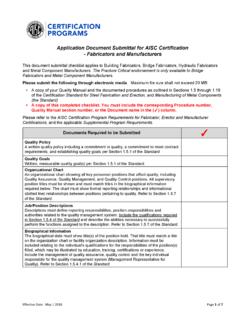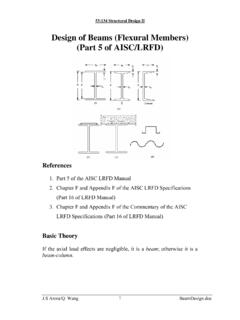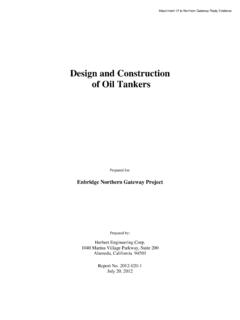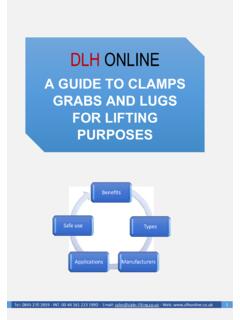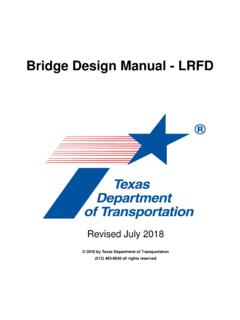Transcription of steelwise - AISC
1 August 2012 MODERN STEEL CONSTRUCTIONSLab EDgE DETaILS whERE the structural frame of the building meets the architectural skin can be cumbersome and complex. But they don t have to be! The design and detailing of the structural components around the slab edge to support the fa ade can have a tremen-dous impact on the overall cost of the project, as well as the fa ade s functionality. There are many factors to consider when developing a design strategy to accommodate the fa ade loads, including the type of fa ade, its location relative to the struc-tural frame, the length of cantilever of the slab past the spandrel beam, the strength of the slab and metal deck and the orienta-tion of the metal deck and adjacent Steel Design Guide 22, Fa ade Attachments to Steel Framed Structures, available on , gives the practicing engineer guidelines to address these issues.
2 This article draws from the design guide to provide tips and consid-erations on how to detail slab edges for supporting fa ade loads in an efficient and economical and ForcesLet s first examine the loads and forces that are involved. The gravity load on the fa ade generally consists of solely the dead self-weight of the fa ade panel. Most fa ades carry no ver-tical live load, but it s important to recognize when there are flat areas that project from the structure and provide working space for building maintenance and window washers. In these cases, live, rain and/or snow loads must also be considered. The center of gravity of the fa ade elements is almost always offset some distance from the centerline of the support locations on the steel frame.
3 This eccentricity between the center of gravity of the fa ade panel and the support loca-tions on the steel frame produces a moment that usually is resolved with a horizontal force couple from the top and bot-tom attachments (as shown in Figure 1). The top attachment may be in tension from the gravity loads due to resolving the eccentricity, and often, negative wind pressures combined with this horizontal force couple will be critical in the design of the fa ade , the weights of the fa ade panels are supported on the slab edge. The slab edge details must transmit these forces and moments into the structural frame without exceeding deflec-tion, tolerance and clearance limits.
4 Conceptually, there are two methods to transfer the forces from the slab edge and into the structural frame:Method 1 The slab and metal deck act as a cantilever to resist the fa ade loads. In this approach, the strength and stiffness of the slab and metal deck resist the shear and moment, essentially treating it like a cantilevered beam to support the fa ade loads. This method is economical when the typical slab and metal deck are adequate or can easily be reinforced to take the additional facade loads. (See Figure 2, p. 18, for free body diagrams of the structural components involved in this method.) If, however, the thickness of the slab must be increased to accommodate the fa ade loads, this may diminish the cost effectiveness of this fa ade panel loads may be transferred into the slab by direct bearing on the slab or by attachment to steel embedments or bent plates that also serve as pour stops.
5 If a bent plate pour stop is used, a steel headed stud anchor or deformed bar anchor is often welded to the pour stop at the end of the slab, which engages the concrete reinforcement and transfers the forces into the slab. The stud or bar attachment cannot be shop-welded when it projects over the spandrel beam, as this would violate OSHA requirements that prohibit tripping FROM ThE EDgEBy Jie ZuosteelwiseConsiderations for detailing the slab edge and designing fa ade Zuo is a staff engineer with aisC and can be reached at 1: Horizontal force couple due to eccentricity. MODERN STEEL CONSTRUCTION august 2012 Resolving the eccentricity of the fa ade load location and the spandrel beam support with the slab and metal deck as a cantilever eliminates the need to design the spandrel beam for torsion or brace it against twist.
6 However, the fa ade load induces negative moment in the slab as it passes over the span-drel, which may require additional flexural reinforcement in the top of the slab in that area. Method 2 A bent plate or other steel assembly is used as a means to transfer the loads to the spandrel. This approach has a load path that bypasses the slab and metal deck; it relies on the strength and stiffness of an attached bent plate , angle or other structural steel assembly to transfer the loads directly into the spandrel (as seen in Figure 3). This method generally is used in cases where the slab and metal deck are inadequate to resist the fa ade loads. Examples of such scenarios include a long, over-hanging slab that produces a large moment or when there is a slab opening in the back-span that limits its capacity.
7 Due to the eccentricity of the fa ade load, the spandrel must resist the induced torsion or be braced against Slab and Metal DeckThe concrete slab cantilever can be designed according to ACI 318 and there exist design tables in AISC Steel Design Guide 22 for flexural strength and slab geometries. When the slab and metal deck act as a cantilever to support the fa ade (Method 1), the fa ade should transfer its loads to the slab through direct bearing. To determine the effective slab width, a conservative approach is to take the effective width equal to the width of the concentrated load plus twice the distance to the line of bending in the slab (as shown in Figure 4, p.)
8 20). Fig. 2: Design concept of Method 1, where the slab is utilized to resolve eccentricity of fa ade panel loads. Fig. 3: Design concept of Method 2, where the spandrel is used to resolve eccentricity of fa ade panel STEEL CONSTRUCTION august 2012 The orientation of the flutes of the metal deck also may affect the effective width and effective depth of the slab. When the flutes are oriented parallel to the spandrel beam, the effec-tive depth is taken at the location where the depth is reduced at the flute; the effective width is unaffected. If the flutes are oriented perpendicular, the full slab depth is effective but the effective width must be reduced to account for the area of con-crete not present in the compression zone.
9 The design guide also addresses other forces that slab and deck must also be able to resist, including forces from kickers or roll (back-up) beams, when used, and the horizontal force couple due to beamIn the case of Method 2, the eccentricity of the fa ade load induces torsion on the spandrel beam. Wide flange sections make great flexural members, but offer little torsional resis-tance and often require bracing against twist. If the spandrel steelwiseFig. 4: effective width for concentrated loads at slab is a girder with in-fill beams framing to it, the secondary framing may provide adequate restraint against twist. If there is no secondary framing, however, the spandrel must have suf-ficient torsional strength and stiffness or additional restraint must be common solution is to add intermittent perpendicu-lar kickers or bracing angles between the bottom flange of the spandrel and the top flange of the first interior beam (as shown in Figure 5).
10 It can also be an anchored connection in the slab. Another common solution is to include additional framing per-pendicular to the spandrel, referred to as roll beams (shown in Figure 6, p. 22). The connections on roll beams must be designed with enough moment resistance to sustain the tor-sional shear. The presence of a kicker or roll beam results in vertical and horizontal reactions in the spandrel, and the hori-zontal force couple between the top and bottom flanges resolves the twisting force. Fig. 5: a kicker brace can be used to resolve the torsion in the spandrel. MODERN STEEL CONSTRUCTION august 2012 Light-gauge Metal Pour StopOne economical slab edge detail incorporates a light-gauge metal pour stop.





